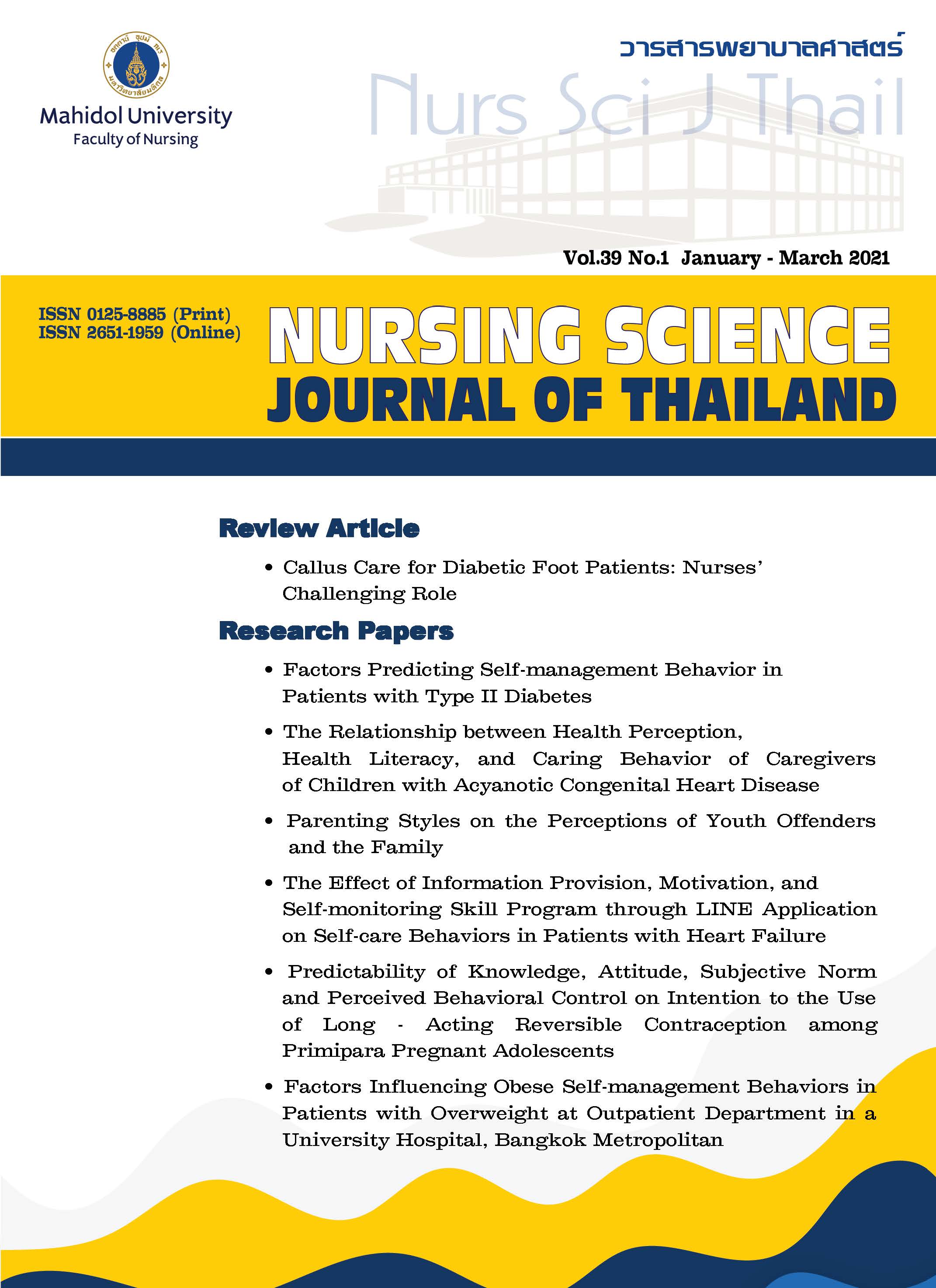Callus Care for Diabetic Foot Patients Nurses’ Challenging Role
Main Article Content
Abstract
Peripheral neuropathy is a common diabetic complication which results in foot numbness, loss of foot sensation, and high pressure in diabetic foot leading to formation of callus which is the most important factor of diabetic foot ulcer that can affect quality of life. Callus care for diabetic foot patients is important for preventing and reducing the risk of diabetic foot amputation. This article provides a comprehensive review and describes the author’s experience with the successful callus care for diabetic foot patients. Therefore, nurses’ role in callus care for diabetic foot patients is of interest and importance that can challenge nurses to apply it effectively in their nursing practice.
Article Details
Copyright Notice: Nursing Science Journal of Thailand has exclusive rights to publish and distribute the manuscript and all contents therein. Without the journal’s permission, the dissemination of the manuscript in another journal or online, and the reproduction of the manuscript for non-educational purpose are prohibited.

Disclaimer: The opinion expressed and figures provided in this journal, NSJT, are the sole responsibility of the authors. The editorial board bears no responsibility in this regard.
References
Mojaddidi MA, Aboonq M, Al Nozha OM, Allam A, EL-Bab MF. Early diagnosis of diabetic neuropathy in Almadinah Almunawwarah. Journal of Taibah University Medical Sciences. 2011;6(2):121-31. doi: 10.1016/S1658-3612(11)70173-1.
Nitiyanant W, Chetthakul T, Sang-A-kad P, Therakiatkumjorn C, Kunsuikmengrai K, Yeo JP. A survey study on diabetes management and complication status in primary care setting in Thailand. J Med Assoc Thai. 2007;90(1):65-71. (in Thai).
Singh N, Armstrong DG, Lipsky BA. Preventing foot ulcers in patients with diabetes. JAMA. 2005;293(2):217-28. doi: 10.1001/jama.293.2.217.
Kosachunhanun N. Pathophysiology of diabetic foot diseases. In: Kosachunhanun N, editor. Prevention and management of the diabetic foot. Bangkok: Trick Think; 2013. p.21-34. (in Thai).
Armstrong DG, Lavery LA, Kimbriel HR, Nixon BP, Boulton AJ. Activity patterns of patients with diabetic foot ulcération: patients with active ulcération may not adhere to a standard pressure off-loading regimen. Diabetes Care. 2003;26(9):2595-7. doi: 10.2337/diacare.26.9.2595.
Callaghan BC, Cheng HT, Stables CL, Smith AL, Feldman EL. Diabetic neuropathy: clinical manifestations and current treatments. Lancet Neurol. 2012;11(6):521-34. doi: 10.1016/S1474-4422(12)70065-0.
Dinh TL, Veves A. A review of the mechanisms implicated in the pathogenesis of the diabetic foot. Int J Low Extrem Wounds. 2005;4(3):154-9. doi: 10.1177/1534734605280130.
Institute of Medical Research and Technology Assessment. Preventive clinical practice guideline and management of diabetic foot complications. Bangkok: Agricultural Cooperatives of Thailand Printing; 2013. 90 p. (in Thai).
Diabetes Association of Thailand, The Endocrine Society of Thailand, National Health Security Office. Clinical practice guideline for diabetes. Bangkok: Aroonkarnpim; 2017. 210 p. (in Thai)
Wannawong S, Wacharanurak P. Knowledge and practice regarding risk screening and diabetic foot ulcer care among community nurses in five southern border provinces. The Southern College Network Journal of Nursing and Public Health. 2015;2(3):62-73. (in Thai).
Pansap K. Factors related to foot ulcer in persons with diabetes [master’s thesis]. Bangkok: Mahidol University; 2009. 128 p. (in Thai).
Moungkum S. Nurses’role in diabetic foot care. Journal of The Royal Thai Army Nurses. 2017;18 Suppl:1-10. (in Thai).
Thewjitcharoen Y, Krittiyawong S, Porramatikul S, Parksook W, Chatapat L, Watchareejirachot O, et al. Outcomes of hospitalized diabetic foot patients in a multi-disciplinary team setting: Thailand’s experience. J Clin Transl Endocrinol. 2014;1(4):187-91. doi: 10.1016/j.jcte.2014.10.002.
Rerkasem K, Kosachunhanun N, Tongprasert S, Guntawongwan K. A multidisciplinary diabetic foot protocol at Chiang Mai University Hospital: cost and quality of life. Int J Low Extrem Wounds. 2009;8(3):153-6. doi: 10.1177/1534734609344143.
Khunkaew S, Supsung A, Sim J, Thaiwong A. Foot health assessment among people with diabetes for healthcare professionals. Songklanagarind Journal of Nursing. 2019;39(3):179-87. (in Thai).
Boonlom T, Siripitayakunkit A, Kanogsunthornrat N. Symptom experiences, symptom management, and outcomes of person with diabetes with lower extremity neuropathy. Journal of Nursing and Health Care. 2015;33(3):16-25. (in Thai).
Tantisiriwat N, Janchai S. Common foot problems in diabetic foot clinic. J Med Assoc Thai. 2008;91(7):1097-101.
Khetgratoke P. The effect of diabetic foot ulcer protection motivation program on foot care behaviors of diabetic peripheral neuropathy in diabetes elderly patients [master’s thesis]. Bangkok: Chulalongkorn University; 2011. 188 p. (in Thai).
Dros J, Wewerinke A, Bindels PJ, van Weert HC. Accuracy of monofilament testing to diagnose peripheral neuropathy: a systematic review. Ann Fam Med. 2009;7(6):555-8. doi: 10.1370/afm.1016.
Sukwatjanee A. Practice guideline for preventing and caring of foot ulcer and lower limb amputation in diabetic patients. Journal of Medicine and Health Science. 2015;22(2):99-107. (in Thai).
Theptarin Cardio-Metabolic Center and Hospital. Preventive foot and wound care training [Internet]. Bangkok: Theptarin Hospital; 2008 [cited 2020 Apr 9]. Available from: https://www.gotoknow.org/posts/162727. (in Thai).
Thai Association of Diabetes Educators. Calllus and corn [Internet]. Bangkok: Thai Association of Diabetes Educators; 2009 [cited 2020 Apr 9]. Available from: http://www.thaide.org/tips/5-2009.pdf. (in Thai).


